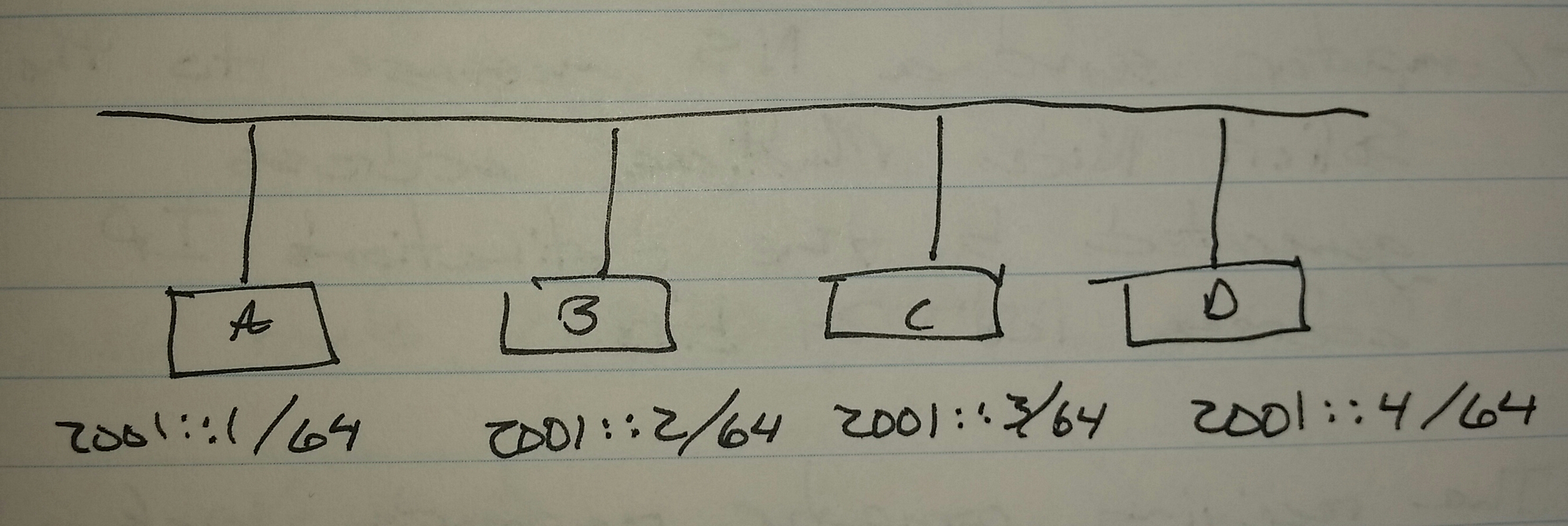IPv6 Notes
IPv6
– 128 bit address represented in HEX format
-> 1 hex = 4 bits
-> 32 HEX numbers = 1 IPv6 address
– 8 quartets (16-bit blocks) or 4 HEX numbers each
12CD:0000:0000:0000:0635:0000:0000:0001 /64
If a quartet has all zeros, it can be replaced with a single zero
12CD:0:0:0:0635:0:0:001 /64
Leading zeros in a quartet can be dropped
12CD:0:0:0:635:0:0:1 /64
Consecutive quartets of zeros can be replaced with a double colon (::) once
12CD::635:0:0:1 /64
Unicast
– Globally unique (public IPs
– Range – 2000:: /3
– 001x -> first 3 bits will always be the same
– Will always start with 2 or 3
-> 0010 – 2
-> 0011 – 3
local-link addresses
– Automatically assigned
-> scope is link-local
– Any interface that has IPv6 activated will have a link-local address
-> Can be changed
– Range – FE80:: /10
Multicast
– Range – FF00:: /8
– The fourth HEX character in the first quartet is called the scope field
-> 2 – scope is link-local
-> 5 – scope is site-local
-> E – scope is global
-> FF0E:: /16 – used on the Internet
Well known multicast addresses
– FF02::1 -> all nodes in the segment
– FF02::2 -> all routers in the segment
– FF02::5 -> OSPF all routers
– FF02::6 -> OSPF all DRs
– FF02::9 -> RIPng
– FF02::A -> EIGRPv6
– FF05::1:2 -> DHCPv6
– FF02::1:FF00:0000 /104 -> Solicit Node Multicast Address
-> first 104 bits stay the same
-> FF02::1:FF
-> last 24 bits can change
-> 00:0000

Anycast
– One – to – one of many
– Any IPv6 address can be flagged as Anycast
IPv6 Address Assignment
int fa0/0
ipv6 enable
-> Causes a link-local address to be generated
ipv6 address <ipv6 add>/<network mask>
-> Manual addressing
ipv6 address dhcp
-> Receive address from DHCPv6 server
ipv6 address x:x:x:x:: /64 eui-64
-> EUI-64 method
ipv6 address autoconfig
-> Autoconfiguration
EUI-64 Method
– last 64 bits (host part) id derived from the MAC address of the interface
-> MAC address -> 48 bits
-> FFFE -> inserted in the middle of the MAC address
-> The 7th bit is then flipped
-> The 7th bit is called the global / local bit
0001.0002.0003 plus FFEE
– Becomes
-> 0001.00FF.FE02.0003
0001 in HEX
– 0000000000000001 in decimal
7th bit flipped
– 0000001000000001 in decimal
– 0201 in HEX
So, 0001.0002.0003 plus FFFE plus 7th bit flipped becomes
– 0201.00FF.FE02.0003
-> host part of the EUI-64 address

Autoconfiguration
R2(config)# int fa0/0
ipv6 enable
ipv6 address autoconfig
-> Receiving side
-> Uses EUI-64
R1 sends periodic Router Advertisement (RA) messages
– Clients can also request an address by sending Router Solicitaion (RS) messages
– RA contains the first 64 bits of router’s address
-> FC01:2:3:4 in this case
– When the client receives the RA message, it uses the 64 bits in the message as the network part and calculates the host 64 bits by using the EUI-64 method
RA / RS messages
– Part of the family of ICMPv6

By default, RA messages are suppressed on serial interfaces
R1(config)# int s0/0
no ipv6 nd ra suppress
R2(config)# int s0/0
ipv6 enable
ipv6 address autoconfig
Serial interfaces don’t have MAC addresses
– Autoconfig on a serial interface will use (borrow) the MAC address of an ethernet interface on the router

IPv6 Neighbor Discovery (ARP)
– NS -> Neighbor Solicitation
– NA -> Neighbor Advertisement
FF02::1 -> all nodes
Solicite Node Multicast group is joined by every IPv6 enabled device
FF02::1:FF00:0000 /104
-> Last 24 bits are taken from IPv6 address of the device
2000:0:0:0:0:0:0:1
-> Last 24 bits – 00:0001
The multicast group the computer will join
-> FF02::1:FF:00:001 – Computer A
-> FF02::1:FF:00:002 – Computer B
-> FF02::1:FF:00:003 – Computer C
-> FF02::1:FF:00:004 – Computer D
Computer1> ping 2001::3
– Computer sends a NS message to the Solicit Node Multicast addressed generated by the last 24 bits of the destinations IP address
– The receiving computer responds back with a unicast NA message which contains the MAC address
Duplicate Address Detection (DAD)
– Devices send NS to the multicast group that itself has joined asking for it’s own IPv6 address
– If anyone else replies, then there is a conflict

